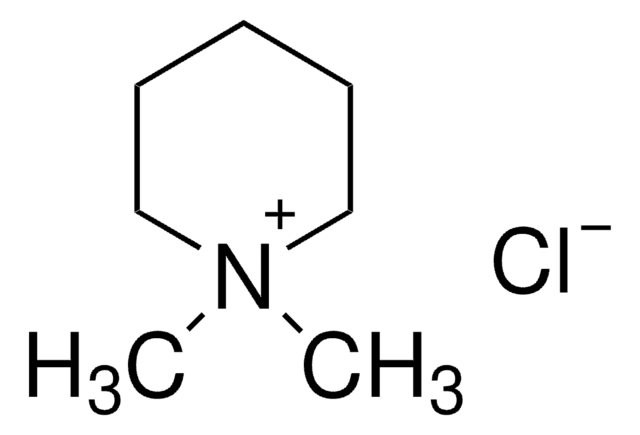93757
Chlormequat chloride
certified reference material, TraceCERT®, Manufactured by: Sigma-Aldrich Production GmbH, Switzerland
Synonym(s):
Chlorocholine chloride, (2-Chloroethyl)trimethylammonium chloride, Chlormequat chloride, Choline dichloride
About This Item
Recommended Products
grade
certified reference material
TraceCERT®
Quality Level
product line
TraceCERT®
shelf life
limited shelf life, expiry date on the label
manufacturer/tradename
Manufactured by: Sigma-Aldrich Production GmbH, Switzerland
SMILES string
[Cl-].C[N+](C)(C)CCCl
InChI
1S/C5H13ClN.ClH/c1-7(2,3)5-4-6;/h4-5H2,1-3H3;1H/q+1;/p-1
InChI key
UHZZMRAGKVHANO-UHFFFAOYSA-M
Looking for similar products? Visit Product Comparison Guide
Related Categories
General description
Certified content by quantitative NMR incl. uncertainty and expiry date are given on the certificate.
Download your certificate at: http://www.sigma-aldrich.com
Chlormequat chloride, also known as chlorocholine chloride (CCC) is the most widely used plant growth regulator that inhibits the biosynthesis of gibberellins. CCC is applied in agriculture and horticulture to promote sturdier growth by reducing the height of grain crops and increasing the diameter of the stems without causing a loss of plant productivity.
Chlormequat chloride has to be monitored in the Multiannual Control Programme for Pesticides Residues (MACP), run within the EU and EFTA in/on products of plant origin.
The European Communities (EC) have established maximum residue limits (MRLs) for CCC at 2 mg/kg for wheat, barley, and rye, 5 mg/kg for oat, and 0.05 mg/kg for other cereals. The agreed values of CCC as reported by EFSA are 0.04 mg/kg bw/day for the Acceptable Daily Intake (ADI), 0.04 mg/kg bw/day for the Acceptable Operator Exposure Level (AOEL), and 0.09 mg/kg bw/day for the Acute Reference Dose (ARfD).
According to Regulation (EU) No 540/2011, chlormequat is deemed to have been approved under Regulation (EC) No 1107/2009. This approval is restricted to its use as only a plant growth regulator.
Application
- Investigate the effect of drought on plant growth, essential oil concentration, oil biosynthesis, and peroxidase activity in the leaves of C. martinii and C. winterianus
- Study the effect of ethrel, chlormequat chloride, and paclobutrazol on growth and pyrethrins levels in Chrysanthemum cinerariaefolium Vis.
- Study the effect of chlormequat chloride (CCC) application at the bolting stage on the flowering, seed yield, and seed quality of lettuce plants previously treated with water or gibberellic acid (GA3)
- Investigate the effects of nitrogen rate, seed rate, and chlormequat chloride on the grain quality of oats (Avena sativa)
Recommended products
Legal Information
signalword
Danger
hcodes
Hazard Classifications
Acute Tox. 3 Dermal - Acute Tox. 4 Oral
Storage Class
6.1C - Combustible acute toxic Cat.3 / toxic compounds or compounds which causing chronic effects
wgk_germany
WGK 2
flash_point_f
Not applicable
flash_point_c
Not applicable
Choose from one of the most recent versions:
Certificates of Analysis (COA)
Don't see the Right Version?
If you require a particular version, you can look up a specific certificate by the Lot or Batch number.
Already Own This Product?
Find documentation for the products that you have recently purchased in the Document Library.
Our team of scientists has experience in all areas of research including Life Science, Material Science, Chemical Synthesis, Chromatography, Analytical and many others.
Contact Technical Service






